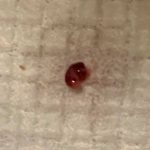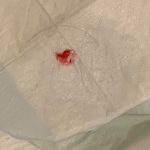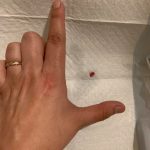Hello,
I’m sorry to hear about your dog. As much as we all want to help it is not legal to prescribe without seeing a veterinarian. You can call your vet and ask for help. But we cannot do it online without a pet existing vet relationship. Further if your dog is injured he may need more than pain meds. Please call your vet, or look for a local mobile vet to come to your home.
My vet thought my cat had a polyp. He went in this morning for them to look into his throat under anesthesia. Turns out he doesn’t have a polyp just has an inflamed throat. They said they can just give him some medicine and he’ll be good. He’s had these symptoms for years.. can an inflamed throat last that long? do you have any advice? will the medicine cure it or just treat it?
Comments
PLEASE HELP ASAP!!! I have a 10 year old black lab and today he was kicked in the side close to his back leg by a horse. I cannot get him in the car to go to the vet. Can I give him aspirin or anything for the pain??? He’s letting me pet him where he was kicked. Can a vet prescribe him any meds without him being seen?
Comments
Hi. I am the proud momma of an amazing dachshund named Gia. Gia is a nine year old beautiful girl who hurt her back on the 18th of September. So far we have gone to the vet twice and one ER visit. Gia is currently taking pain medication and a muscle relaxer all of which are helping with the crate rest. My question is, how long before she starts to feel a little better? I heard that 6-8 weeks of crate rest at minimum, and I am worrying because this is the first time that I have seen Gia be so lethargic. The YouTube videos that I saw were extremely encouraging to a person who is going through an IVDD suspect injury.
Hello. My vet suspects my cat has one or more nasal polyps. I’ve been going through this process of getting towards his surgery for a while. The vet told us he has a heart murmur, but only a grade 1 out of 6, I brought him to a 2nd vet and they said his heart sounds great, I went back to the first vet and they looked at him again and the doctor said he has a murmur and even his vet tech looked over it and didn’t hear it the first time and the doctor had to tell her where to listen and she finally heard it. They said we would need some test on his heart before during surgery to make sure his heart doesn’t fail while under anesthesia. I got an x-ray done of his heart which came back fine and i also got blood test done which came back fine. The test he got were included in the basic wellness screen. I’m thinking he has a intermittent heart murmur because of his heart rate going up due to stress of being in the car and at the vet. The vet is still telling me i can have an echocardiogram done to be really sure his heart is really fine. That’s another $390 on top of the $500 i’ve already spent and i just can’t afford it. I believe if 2 vets could simply look over it, and it’s only a grade 1/6, and the test and x-rays came back fine so far, he should be good… right? Well another thing is they don’t know how many polyps he has or where exactly they’re located, we asked for a throat/head xray and they told us they can only do it if he’s under anesthesia first. They are adding on so much stuff i feel like he doesn’t even need and gave us a price estimate from $450-$1,500. We asked the other vet and they said they can do a head x-ray, but they don’t even know if the procedure of removing the polyps is even anything they can do, and he might have to go to a specialist. Can the polyps for sure be seen on the x-rays because i really don’t want to waste any more money on something that doesn’t even help get down to the problem. I’m thinking i can just skip over the echocardiogram because it doesn’t seem it’s really needed, i get an x-ray of his head, find the size, how many, and where the polyps are located, then get a real price estimate. Can someone please answer my questions or give any advice! Thanks:)
Comments
Hello. My 16 year old female burmese “crashed” Feb 29, and March 2nd was diagnosed with Feline Lower Urinary Disease and Chronic Kidney Disease.
Her Kidney values are now stable and her only elevated numbers are Creatanine at 2.6 and Bun at 46
but her bladder keeps flaring up
When diagnosed she was shooting projectile urine. Her bladder wall was thickened. Covenia did nothing but Amoxycillin resolved the infection.
2 months later she had a couple of accidents and it appeared that she had another infection. Once again Amoxycillin worked! She had a culture done and it showed no bacteria..
She has been taking supplements Kidney Gold, and Moxxor Fish Oil since April, and started CBD oil around June
Late July I started her on D-Mannose and COrn Silk Extract as suggested in the FLUTD facebook group
last month she started peeing blood clots, Vet instructed me to give her Sub Q 100ml to flush her and start amoxycilin immediately.. 7 day course and she was fine, but 2 days after the course finished was a repeat episode.
This time the vet suggested a higher dose at 1ml morning and night for 10 days.. Well it seemed to work amazing but last night was exactly FIVE DAYS after stopping the amoxycillin and she had another episode
We are doing a third round of antibiotics, this time amoxy mixed with something stronger..
He asked me to stop the corn silk and D-Mannose completely since they were the newest added to the regeme and he is wondering if they could have changed her bladder PH for the negative.
How can I minimize the recurrence?
Oh I have read all about stress being the cause and my new born baby was 4 months old at the end of Feb when Tashee had her first crash.
My vet and I talked about future possibilites in regard to Amitriptaline, Gaberpenton, Adequan injections
Cat’s diet = she refuses any wet food besides kitten fancy feast.. she will not eat anything else and will starve herself.
She is offered 2 fancy feast cans per day
she does steal dry kibble so my vet told me to get the Royal Canin Kidney kibble so that when she eats kibble its good for her
Sub q is 150ml twice a week as to minimize the pressure or force on urethra.
Cat is 100% indoors, burmese female steralized
Comments
Hi Can you please help me with a puppy crate question?
Our now almost 12 wk old golden puppy has been crated at night for 3 weeks and he is still up every hour crying..
I let him cry for about 20 min at most and he usually falls back to sleep but then wakes up again an hour later..
I will take him out only once a night (for a very boring and quick trip outside to potty) if the crying
lasts longer than about 25 min
Because I’m Exhausted… I finally caved and moved him into our bedroom in the crate (where our older dog sleeps on a dog bed) and he has slept through the night for the last three nights…
But….I hear him panting and moving around all night so I can’t sleep!
Is it okay to put crate in the basement where I won’t be able to hear him and just let him cry it out?
I’ve never had this problem with previous puppies…
Any advice you can give would be greatly appreciated!
Thx!
Sarah
Comments
My 7 month old retriver puppy has real behavior issues I cant seem to break. I cant afford a dog trainer since everyone I’ve contacted wants atleast $500 for 5 hours of basic training. The problems: she pulls on the leash…hard. she is constantly chewing on stuff. Anything in the floor. As soon as i turn my back shes into something… the trash, litter box, cat food, chasing the cats… she knows it wrong because when she sees me she looks down in shame. I have a prong collar for walking her, a shock collar for teaching her no. She’s smart and knows how to come, sit, lay, catch, drop it… However now she refuses to drop something she really wants. I cant give her chew bones or long lasting treats because she’s started growling and snaps at my kids when they come near her with it. I have a crate, that I put her in when she being bad. She refuses to calm down at all when there is something interesting like new people or another dog. I spend my entire day scolding her for doing bad things… so much to where I really dont want to be around her anymore. My kids hate her, and my husband is trying so hard to like her. Im at a complete loss as to how to train her to calm down and stop doing things she knows she isn’t supposed to do. I have a severe back injury and it is really hard for me to contain her when she’s acting a fool. Ive also tried having turkey in a treat pouch and only giving it to her when she’s being good. Which she will do till I run out then she’s right back at it. If anyone has any ideas please let me know.
Comments
Hello,
I am searching for a vet to help me with my dog Hazels tooth extractions (right molar). She is in much pain and does not want to eat. If she eats, she eats very slowly. Any information on pricing, veterinary clinics, and scheduling will be greatly appreciated.
Thank you!
Bryan
Comments
Hi, while looking for information about my 15 yo beagle’s combination of symptoms, I came across IVDD and a youtube video about Hank by Dr. Krista Magnifico. Several years ago, my beagle started having short tremors that would last a few seconds. Those are fairly common now, occurring multiple times an hour. Last year, she became incontinent at night, and leaked sometimes during the day. She is on Proin for that, and it has mostly stopped that issue. And in the last few months, her legs have started giving out from time to time. She doesn’t seem to act like she’s in pain, though she pants a lot, but always has, especially in the evenings. I have some short videos showing the tremors and her legs giving out, and I can provide you a link to Google photos if Dr. Magnifico would view them and let us know if it looks like IVDD or not. Thanks!
Comments
Hi Dr Magnifico . . . . first, thank you for catching our pony that got loose earlier this summer. I still can’t believe she ended up 4 miles away! But she has stayed put since. I am writing because your front desk told me to reach out to you on here. We are going to be changing vets. Our current small animal vet is just too pushy with trying to sell me everything under the sun, but mainly I have concerns with our one dog going there. He is a 5 yo pitbull. I took him to PennVet Behavioral vet about a year and a half ago upon recommendation of our vet. They diagnosed him with Generalized Anxiety Disorder and prescribed him gabapentin. Our primary vet later changed to fluoxetine and he does really well on that. However, he gets nasty when he’s scared . . . especially at the vet. I muzzle him and feed him peanut butter through the muzzle to try to show him it’s all okay (all recommended by Penn Vet). I give him composure pro prior to the appointment. He is just very scared there and as a result growls and snarls, etc. The current vet is so scared of him she doesn’t even touch his stomach, look in his ears or eyes, etc. I am looking for a vet who can remain calm/reassuring for the dog and show him he has nothing to be nervous about and doesn’t mind completing a thorough exam on him, with his muzzle on of course. Please let me know if you feel your facility would be a good fit for him and which vet we should schedule with. He needs his fluoxetine refilled soon and I hope we can find the right fit before then. Thank you!











Hello,
I’m glad they looked for you and hopefully started to give you some answers. Yes you can have chronic inflammation. Ask your vet for a short and long term treatment plan and then start there. Good luck.